The Striper Breakdance
Eliminate slack and keep your lure still in the strike zone to consistently catch stripers just off the beach.
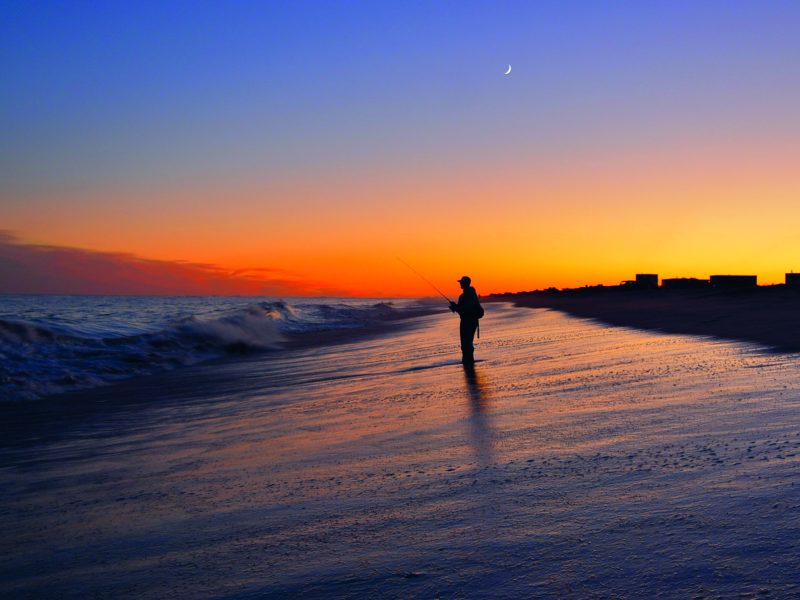
To deliberately target a fish, I must know where it is and what it is willing to eat. The fish has a routine and my goal is to hijack that routine. It is looking for food and I am here to feed it. If I persuasively display the desired food in the fish’s path, my hook will get eaten. If my line’s tight when the bite comes, I’ll feel the bite and hook the fish.
The following technique will make surfcasting with spinning gear a lot easier. Your cast-to-catch ratio will go up, and your confidence will skyrocket as a result. If you practice enough, you might even need to pick up a fly rod to make catching surf stripers challenging again.
I have fished 350 days a year for the past decade. Most of them, from May to December, are spent in the suds. I live on an ocean beach and was an ocean lifeguard for a long time. I developed this technique after many, many hours of analysis and practice. I hope this article will make you a better striper angler and you’ll want to go get a fly rod.
The “breakdance” is a mending technique used in the ocean surf to deliberately single out striped bass that feed along the beach lip. This approach relies on the assumption that bass on sand beaches prefer to swim and feed right along that lip. In my mind, this is a fact, but it’s not as simple as “accept this fact and you’ll catch more fish.” There are a few obstacles to overcome before you’ll start catching more consistently and this technique requires some practice to be effective. Furthermore, if you don’t possess ample patience, this just might not be for you.
This method shines in what I consider the most difficult surf conditions. When long-period east swells push their mountainous, gin-clear waves onto the summer sand of an Atlantic beach, catching stripers seems impossible. A heavy wave heaves a tremendous amount of water over the beach lip, some of which will run up over the berm and create tidal pools, but most of it runs back downhill into the sea as “backwash.” The water flows down, and all that’s left in its stead is wet sand. Moments later, that sand again becomes covered by water after the next wave breaks. The direction of the current caused by the waves switches constantly, from seaward to shoreward. Every time a wave breaks, thousands of small morsels get knocked from their hiding places and become victims of the currents. Striped bass spend much of their time in these currents, effortlessly surfing the heave and the backwash, capitalizing on a brief yet consistent feeding opportunity. Therefore, the area around the beach lip is the predominant feeding locale for sand-beach striped bass throughout the year. This is the premise for the breakdance. Implement it and you will catch stripers on days when you thought it impossible.
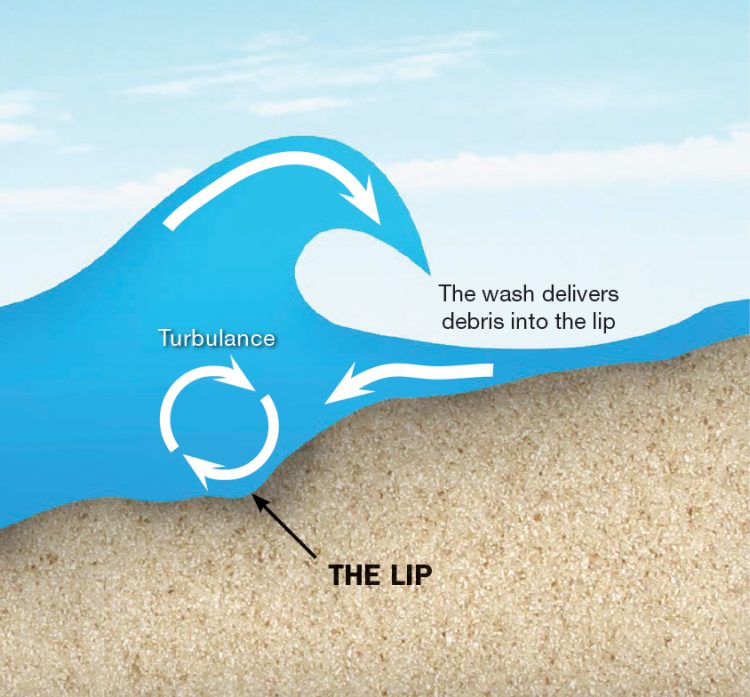
I fish this breaker zone exclusively but standing there during these conditions can be very dangerous. The backwash can suck you right into the suds, and the big waves may cause a concussion when they hammer you into the sand. First of all, never turn your back on the surf, especially during an east swell. It’s important to always be wary of these currents, solely for your safety. Always watch the ocean and you will come to know it intimately; with that increased safety will come prowess. You’ll recognize when big sets are coming, which happen to be the best feeding opportunities. You’ll notice ripples that don’t conform to the natural order, indicating the presence of fish.
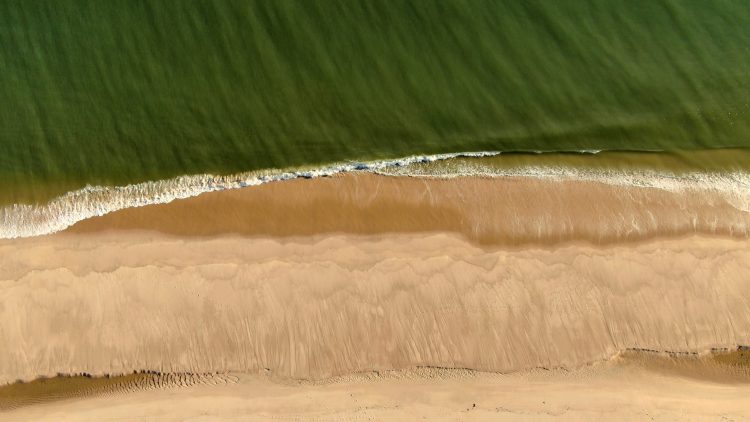
The breakdance helps any angler catch striped bass on a sandy ocean beach. I teach this method to everyone I coach in the surf. Even day-one rookies catch bass like they’ve been doing it for years, so I’ll pretend this is one of my guided trips:
Your job is to stay tight to the fly or jig while keeping it motionless on the bottom. You must keep the line between your rod tip and your hook as straight and tight as possible without moving the lure. I constantly repeat “don’t move the lure,” and “stay tight to your lure,” during my lessons. If either of those commands are disregarded, even for a second, fish don’t get caught. You need to stay tight to feel the hit, and your lure should be nearly motionless to persuade the fish to eat.
If done correctly, the breakdance will keep your bait, lure, or fly near the beach lip for as long as possible. There are almost always stripers swimming along this berm during the summer and fall. Especially on the days when the fish seem to have lockjaw, moving your offering extra slowly within a few feet of the beach lip will force those maws to open. Stripers find it hard to refuse a small, slow-moving meal.
The purpose of the breakdance is to eliminate drag. If you fly fish, you probably know that you can eliminate drag by mending, or you can use drag to present your fly “on the swing.” If this all sounds foreign, let me quickly catch you up. “Drag” occurs when a force (current) pushes on your line and drags your hook. You’re not actually retrieving any line, but your lure is moving. Imagine casting a surface lure across a small choke point on a moving tide. Your lure lands in completely still water, but your braid is lying across that very fast current coming through the choke. The current will push the slack out of your braid, creating a crescent shape in your line. Once the slack’s out, the line is tight and the current pushes on your tight, U-shaped line to make your lure move. You’re not reeling, but your lure is moving. This is “drag” at work.
Fly fishers must consider the effects of drag almost every time they cast. Thick floating line doesn’t cut through the water as easily as braid, so drag is an ever-present complication. Spinning gear is less complicated because of the thinner line and heavier weight at its end. Spin anglers typically needn’t worry about these side-to-side currents pulling on braid and causing drag; they can just tie on something a half-ounce heavier to hold the bottom. However, when the ocean surf is your arena, another form of drag comes into play that concerns both fly and spin anglers alike. When your offering gets close to the beach, you are going to experience drag when a wave breaks on your line. It’ll quickly move your lure, leaving slack in your line when the wave passes. Contact is lost, and the urge to rip it in for another cast becomes irresistible.
Most surf anglers are guilty of prematurely pulling their presentations out of the strike zone. It is a psychological dilemma: you aren’t tight to your lure after a wave breaks, so you don’t know exactly where it is anymore. Perhaps a fish just ate it, but you didn’t feel the bite because you’re not tight. So, you speed up your retrieve until you feel it again, but as soon as you feel it, another wave breaks on your line and contact is lost. It is a vicious cycle, and most of us probably just sprint it in toward the end if we haven’t gotten a hit. Fact is, we’re sprinting the lure right through the entire strike zone.
The strike zone is in the vicinity of the beach lip. It’s about ten feet behind the lip (underwater) and 5 feet above it (in the heave/backwash zone). Striped bass often swim parallel to the shoreline, underneath the building and breaking waves. When a wave crashes, stripers ride the forward momentum up over the beach lip. The area floods, and all sorts of prey get jumbled about in the shallows—sand fleas, shrimp, spearing, shellfish, and more. Stripers grab a quick bite and then ride the backwash down below the beach lip. What was just an inches-deep aquarium filled with thousands of critters is now just wet sand. Some of them are caught in the backwash and get dragged below the berm; the stripers will eat the ones that cannot quickly disappear. This happens hundreds of times a day, making it the most consistent striper fishery I have come across. Tide doesn’t seem to be a concern most of the time.
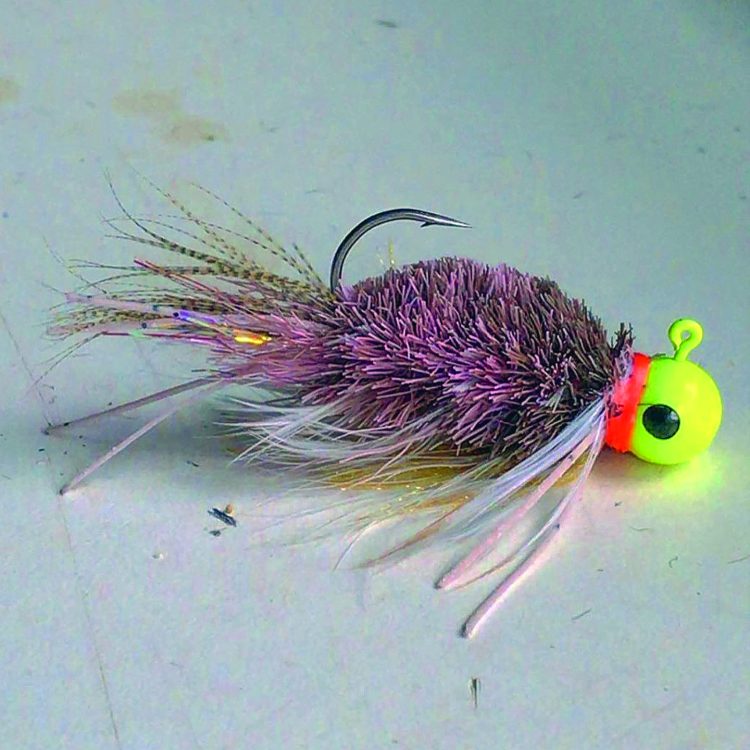
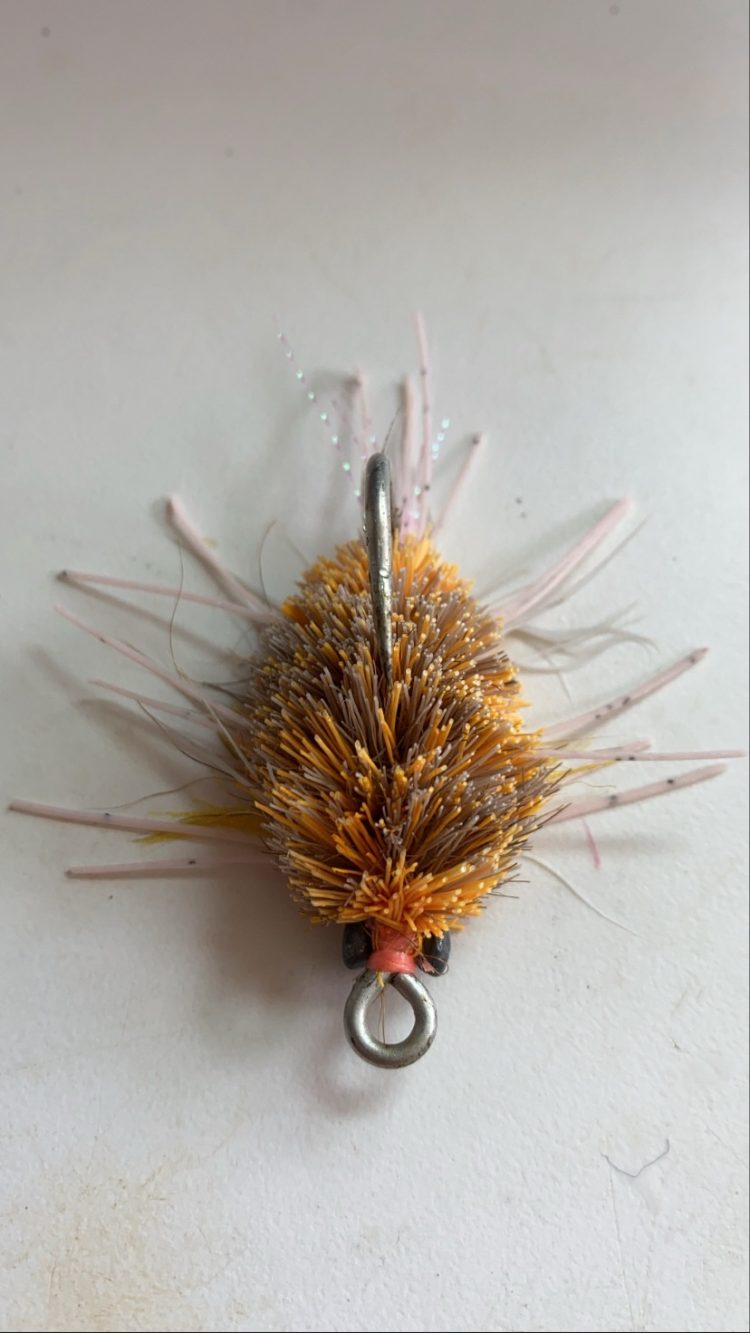
You can catch these stripers without knowing any of the above—that’s called luck. The breakdance leaves luck behind and makes fishing deliberate.
I mentioned “mending” before, and the breakdance is the implementation of multiple mends to cancel out drag. Upsweep mending is when you remove the U-shape from your line by lifting the rod and throwing/placing your line further upsweep. This introduces slack to the section of line stuck in the fastest current, so your fly will not be dragged until the line comes tight again. A good upsweep mend will hardly move your fly, and it will give it time to sink. I mend constantly to make my fly sink, to keep it on the bottom, and then to prevent it from moving. Essentially, what I’m doing is a “greased line swing,” although I am trying not to let the current swing my fly. I want that fly motionless on the bottom, so I use constant upsweep mends.
Drag caused by white water affects both spin and fly anglers, though. On a calm day, just lift your rod tip enough to bring your line over the white water, and that will be enough of a mend.
If you consider, however, the more difficult conditions I mentioned earlier, you won’t be able to avoid the white water just by lifting your rod tip. The big heaves and strong backwash associated with an east swell make the surf zone treacherous since waves grow taller when they come from the east. More water is being pushed further up the bank, so some extra work is necessary to cancel out the white-water drag. We’ll have to dance with the breaking waves.
The Breakdance
A wave’s life cycle is as follows: it builds, crests, crashes on shore, the water runs up the berm, then it falls back down the berm. The backwash usually runs right into the next wave.
To present to stripers feeding at the lip, walk toward a building wave, stop right before it begins to break, and then go in reverse once you see white water. Back up the berm with the heave, and then walk toward the sea with the backwash as the next wave is building/cresting.
As a wave builds, I walk toward it. While I move forward, I raise my rod tip and simultaneously strip line through my rod tip to reduce the amount of slack between the breaking wave and me. There is usually no more than 10 feet of slack to manage so I hold onto it as the wave begins to crest. Just before the white water appears, I wiggle my rod tip to unglue the last of the line from the water’s surface. At the last second, I give my rod tip a quick lift with a flick of my wrist to snap the last of the line off the surface and over the white water.
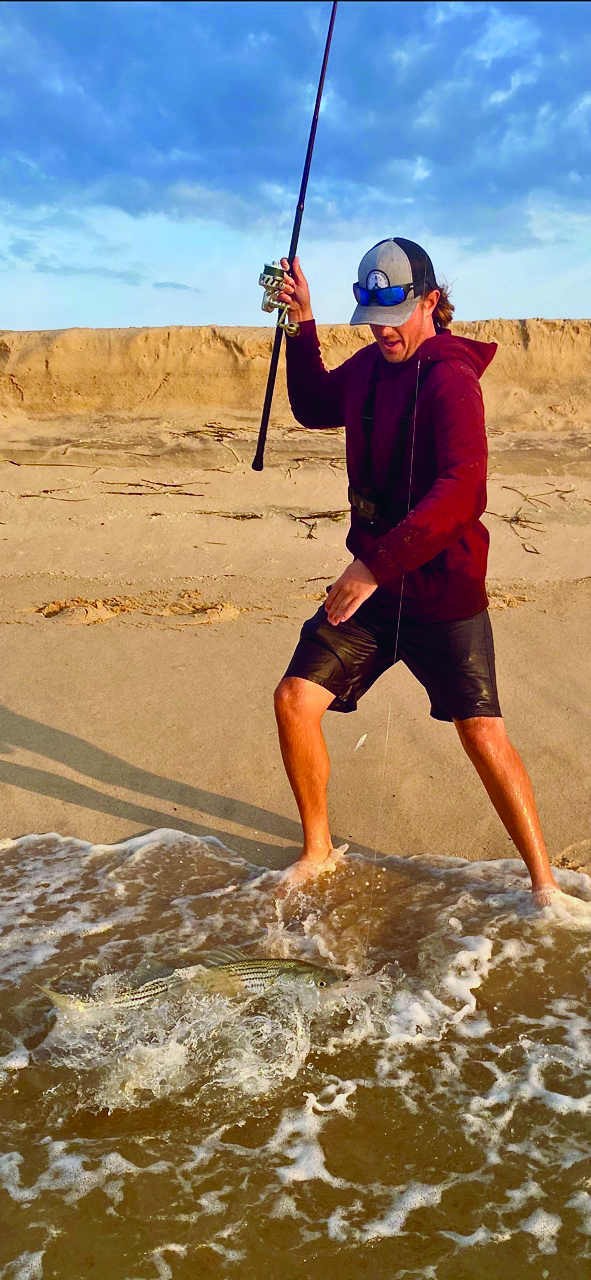
As the white water is falling toward me, I am just feet away from a breaking wave, and it will destroy me if I don’t run away from it. If I survive that but stay still, the backwash will overpower me and suck me into the sea. So, I very quickly move backward, making sure I’m facing the ocean. Remember, never turn your back on it.
As I’m moving backward, my rod tip stays high above the white water and I release the slack line in my stripping hand in a controlled manner. If I don’t release that slack line, my backward steps will cause the fly to move. We don’t want that fly to move at all! Back up as far as needed—to remain safe but also remain in the game.
The wave crashes and the water rushes over my legs. I feel the sand fleas getting tossed around, and I see a bunch of ripples around the beach lip, even above it near my feet. (The ripples are from feeding fish.) As the water begins to recede, I move quickly toward the ocean with it. Another wave will break in just a few seconds, and I need to repeat the process again.
If I perform this tactic perfectly, my fly will not be dragged by the white water at all. The sweep might move it a bit to the side, but as long as it’s within those magical 15 feet of the beach lip, the stripers won’t refuse it because of a little movement.
The ultimate presentation is achieved when you combine good upsweep mends with a proper breakdance. In my experience, it is the most consistently reliable approach to catching stripers from sand beaches.
Leave a Reply